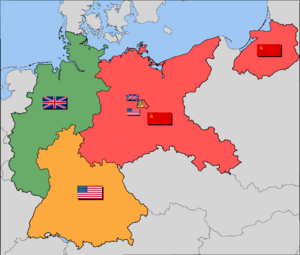Soviet occupation zone of Germany facts for kids
Quick facts for kids Soviet occupation zone of Germany
Sowjetische Besatzungszone
Sovetskaya okkupatsionnaya zona Germanii
|
|||||||||
|---|---|---|---|---|---|---|---|---|---|
| Military occupation zone of the Soviet Union | |||||||||
| 1945–1952 | |||||||||
 The Soviet occupation zone in red |
|||||||||
| Capital | Berlin | ||||||||
| Government | |||||||||
| • Type | Military occupation (member of the Eastern Bloc) | ||||||||
| Military governors | |||||||||
|
• 1945–1946
|
Georgy Zhukov | ||||||||
|
• 1946–1949
|
Vasily Sokolovsky | ||||||||
|
• 1949
|
Vasily Chuikov | ||||||||
| Historical era | Post-World War II Cold War |
||||||||
| 8 May 1945 | |||||||||
|
• German Democratic Republic established
|
7 October 1952 | ||||||||
|
|||||||||
| Today part of | Germany | ||||||||
The Soviet occupation zone was an area in Germany controlled by the Soviet Union. This happened after World War II ended in 1945. It was set up based on an agreement called the Potsdam Agreement.
This zone was one of four areas that the winning countries (the Allies) took over in Germany. The Soviet Union was given the central part of Germany. Other parts of Germany were occupied by the United States, the United Kingdom, and France.
Contents
How the Zone Was Formed
After World War II, the Allied powers divided Germany. The Soviet Union was given control over a large central area. This area was known as the Soviet Military Administration in Germany (SMAD).
Before the zones were officially set, British and American forces had moved into some areas that were supposed to be the Soviet zone. However, by July 1945, these areas were given to the Soviets. This followed the plans made earlier for how Germany would be divided.
Political Changes in the Zone
The Soviet leaders allowed new political parties to form in their zone. But these parties had to work together in a group called the "Democratic Bloc." Later, this group became known as the National Front.
In April 1946, two major parties, the Social Democratic Party and the Communist Party, were made to join together. They formed the Socialist Unity Party of Germany. This new party later became the main ruling party of East Germany.
The Soviet administration also set up some special camps. These camps were used to hold people in the zone. Some of these were former camps used by the Nazis.
States and Districts in the Zone
In 1945, the Soviet zone mostly included parts of a larger German region called Prussia. Prussia was later broken up by the Allied powers in 1947. The Soviet zone was then divided into several German states, called Länder. These included Brandenburg, Mecklenburg, Saxony, Saxony-Anhalt, and Thuringia.
On October 7, 1949, the Soviet zone officially became a new country. It was named the German Democratic Republic (GDR). People often called it East Germany. In 1952, these states were changed into 14 smaller areas called Bezirke (districts). East Berlin also became its own district.
The Cold War and East Germany
By 1952, the Cold War was in full swing. This was a time of tension between the Soviet Union and Western countries. Joseph Stalin, the Soviet leader, suggested that Germany could be reunited. He wanted it to be a neutral country, meaning it would not join either side.
However, the Western powers were not interested in this idea. This decision helped to make the Soviet zone a separate country. It remained East Germany for the next 40 years.
West Germany, which was the part of Germany occupied by the Western Allies, did not recognize East Germany as a real country for a long time. They often called it the "Soviet zone" or "the so-called GDR." This changed in 1972. The West German government, led by Willy Brandt, started to accept East Germany's existence. This was part of a new policy called Ostpolitik.
See also
 In Spanish: Zona de ocupación soviética para niños
In Spanish: Zona de ocupación soviética para niños
- Allied-occupied Austria
- History of East Germany
- Bizone
- Trizone
- Group of Soviet Forces in Germany
- Stunde Null





